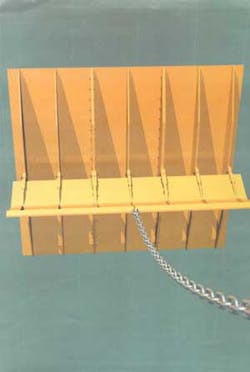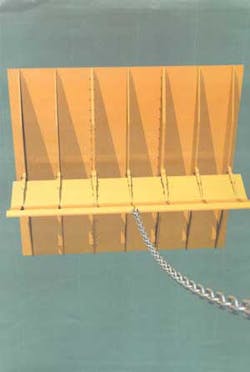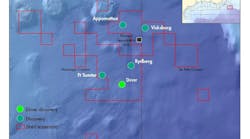DEEPWATER MOORING: Anchor loading, mass distribution vary to achieve different goals
Three key concerns associated with deepwater moorings are the interaction between large vertical loads and a soft seabed soil, the potential for resonance resulting from equipment loads during lowering to the seabed, and mooring line handling constraints.
The appropriate anchor solution should involve low weight and little added mass, capable of resisting large and permanent vertical load components. The system should preferably be handled by a non-sophisticated vessel, and easily overboarded over the vessel's stern.
Conventional suction piles employ the upper part of the anchor to penetrate the lower part of the anchor into the higher holding capacity soil below the seabed. As a result, the upper part of the anchor adds weight and cost to the system, but does not contribute any significant holding capacity. A conventional suction pile will also have high added mass during lowering to the seabed, and may resist the permanent vertical loads inefficiently due to shear developing on the vertical wall penetrated into the soil.
These installation-related problems can be surmounted through splitting the anchor into two components - one being the actual load-holding part of the anchor and the other, an 'installation lid.'
The latter serves to embed the first part down to the high-holding-capacity soil. The installation lid can be retrieved and re-used as an option, which means it can also be equipped with a properly sized vent and a larger, more expensive hatch that will reduce the added mass considerably.
Pre-installation
In this way, anchors can be pre-installed on location and connected to the installation lid subsea. Consequently, the installation lid can be transferred to the seabed only once during installation of the anchors. The sequence is as follows.
- The installation lid is lowered to the pre-installed anchor, connected with the two and penetrated down to the desired depth.
- The lid is then released, retracted from the seabed, and transferred to the next anchor without retrieving it to the vessel on the surface.
Potentially, this last step can cut installation times and in turn lower the installation cost. Efficiency of the anchors for resisting permanent vertical load components is improved by adding structural members that resist such loads by mechanisms of bearing capacity, not by shear on vertical walls.
ABB developed some anchoring solutions to deal with the movement into deeper water, greater anchoring loads, and the numerous steps in moving and re-locating anchors. These solutions include a high capacity anchor (HiCap), a high-capacity, low-weight anchor (Blade), and a high-vertical-loading capacity anchor (HiVel).
Loading cases
The high capacity anchor was developed for multi-line catenary and semi-taut mooring systems, and Norsk Hydro selected this version for mooring of the Visund floating production unit in 1996. This version is formed as an open cylinder with a detachable and re-usable installation lid (follower) that installs the anchor about 4-6 meters below the mudline.
This means that the non-holding and low-holding areas found on traditional 'bucket' suction piles are eliminated. Furthermore, this configuration makes it impossible for a gap to develop behind the anchor, a situation that can undermine other anchors' holding capacity in certain soil types.
The high-capacity, low-weight anchor was developed largely for catenary moorings and in applications where logistics require minimum transport volume and weight. Its main components are a vertical plate of low penetration resistance (blade) stiffened by vertical ribs, and a series of flaps hinged horizontally together and to this plate. The mooring line is connected to the outer flap, leading to the mooring load being transferred to the soil partly by the flaps and partly by the vertical plate. The flaps are designed so that only horizontal loads are exerted onto the vertical plate. Increasing the flap area results in smaller vertical components acting on the vertical plate, plus larger anchor capacity.
The high vertical loading anchor is particularly suited to taut moorings, single-point moorings, and moorings exposed to vertical or near-vertical loads and soft-to-very-soft seabed soil. ABB claims that this is one of the safest solutions available for taut mooring with steep or vertical mooring legs in locations with soft seabed soils. It can be designed to withstand loads in any direction above the seabed, making it suitable for use with riser towers and other deepwater riser support systems.
The high vertical loading anchor's main component is a cylindrical ring with internal stiffeners across the diameter (as is the case with the high capacity anchor). However, inside the ring of the high vertical loading anchor is a set of simple flaps, which open to facilitate penetration into the soil with low penetration resistance.
Upon reaching the target penetration depth, the anchor is retracted slightly, following which the flaps react with the soil and close. In this way, the flaps create a soil impenetrable bottom in the cylindrical ring to enable the embedded anchor to support the transfer of large vertical mooring loads.




